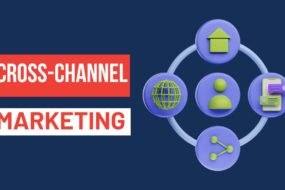
How do you execute a successful rebranding campaign? What should you expect during the process? How will everything turn out in the end?
This article will provide the information needed to address these inquiries and lay the groundwork for a smooth and successful revamp of your firm’s brand. Every firm is different, but there are rebranding strategies that work for all companies, regardless of size or industry.
We will explore the typical steps for rebranding a business. Learn how to rebrand your company in six steps that deliver clear messaging, strong differentiators, and a fresh visual identity. Let’s begin!

What Is Rebranding?
Rebranding is changing a company’s corporate or brand identity, typically through adopting a new name, logo, design, or messaging. It involves significantly changing the visual, verbal, and experiential elements representing a company to its target audience.
Bullet-Proof 6-Step Rebranding Process
You can only spend time and money rebranding your firm with a plan. Conversely, a solid foundation and systematic approach will ensure a smooth and enjoyable process. The following step-by-step process is based on years of experience from rebranding firms. Each step builds on the one before, which is precisely why this plan works.

1. Think About The “Why”
Understanding your reason for rebranding is the first step to any rebranding strategy. Does it stem from a desire to accelerate growth? Are your competitors larger and more established?
When your business reason is unclear, you risk wasting time and resources. Here are some other top reasons you may wish to rebrand:
- The brand you once had does not reflect who you are today.
- You need To strive at an elevated tier of competition or venture into a fresh market.
- There are legal reasons for you to make the change.
- Your brand is a spin-off of an existing company.
- Your company is launching a new product line.
- Your marketing team has changed.
- Your message needs to be simplified and focused.
2. Examine Your Target Audience
As soon as you’ve established the business case for rebranding, it would be best to research your prospective clients. It is crucial to understand how your current brand is perceived and how it is performing.
You can only operate from an internal perspective if you do not conduct this research. Most firms have blind spots, distorting their market perception. We are all human, after all. A brand built without objective analysis risks being based on faulty assumptions.
3. Set Up A Consistent Messaging Architecture
Developing your company’s market position and messaging architecture will help you identify the essence of your brand strategy. A market positioning statement summarizes where you fit within the market. Do you lead the way in innovation or provide low-cost services?
The positioning of your company will determine many of the decisions you make in the future. However, you cannot just make things up. As a firm, you need to balance what you are and what you aspire to be. If your positioning is not supported, your brand will lack credibility.
A messaging architecture outlines the messages you want to communicate to each of your primary audiences. Consistent and believable messages are essential. Essentially, this is the framework for your marketing copy.
4. Establish Your Visual Identity
This is part of the branding strategy, where you create the visual elements to convey your brand’s message. Consider your brand name, tagline, logo, colors, stationary, business cards, etc. Brand style guidelines provide a set of parameters for ensuring your brand is consistently portrayed in all your marketing materials.
These elements often need clarification with a brand. However, branding isn’t about the name of your firm or its logo; it’s about your reputation and visibility. The visual identity is your brand’s visual shorthand.
5. Grow Your Online Presence
Nowadays, your website is the most crucial tool for communicating with customers and developing your business. Using it, you can convey a compelling message to your target audience. Prospective clients and employees will go there first to learn more about your company. You can reach agencies interested in your project through an effective website proposal request.
Your website will inevitably play a role in any rebranding strategy. Websites are built around your messaging architecture. This is your complete online presence and other channels you may use (such as social media).
6. Stick To The Plan
To strengthen your new brand, you must develop (and stick to) a promotion strategy. Firstly, your employees must embrace your unique brand. In the end, they are your most important brand ambassadors.
Additionally, you should communicate your firm’s reputation and expertise, not just try to get its name in front of as many eyeballs as possible.
Specific rebranding approaches falter when they attempt to speed up the process. Other companies fail because they work with the wrong partners. Make sure your rebranding strategy is sound. Find a partner with experience.
You will reap the rewards of rebranding if you give it the attention it deserves. Well-positioned companies that communicate their brand are formidable competitors.
How Do You Announce Rebranding On Social Media?

Announcing a rebranding on social media is a successful method for connecting with a wide-ranging audience and generating excitement around the new brand identity. Here’s a step-by-step guide on how to announce a rebranding on social media:
- Plan your announcement and create a comprehensive strategy.
- Build anticipation with teaser campaigns.
- Reveal the new brand identity, including the logo and visuals.
- Share the story behind the rebranding and its motivations.
- Encourage audience engagement and feedback.
- Utilize visually appealing content like images, videos, and GIFs.
- Use relevant hashtags and tag key stakeholders or influencers.
- Cross-promote the announcement across all social media platforms.
- Involve employees in sharing the rebranding news.
- Monitor social media platforms, respond to comments, and track performance.
More Reads – A Beginners Guide To Types Of Social Media Marketing
Examples Of Notable Rebranding Efforts By Companies

These examples demonstrate how companies undergo rebranding efforts to update their visual identity, align with strategic shifts, communicate a new direction, or connect with evolving consumer expectations. Here are the examples of rebranding.
Microsoft
In 2012, Microsoft underwent a major rebranding to reflect its shift from a software-focused company to a devices and services company. The new logo featured a simplified four-colored window pane design, representing Microsoft’s diverse range of products and services.
Uber
2018 Uber revamped its brand identity to signify a shift towards a more mature and diverse company. The new logo featured a simplified “U” in black and white, a custom typeface, and a vibrant color palette—the rebranding aimed to convey a more inclusive and forward-thinking image.
Airbnb
In 2014, Airbnb unveiled a new logo and rebranding effort that showcased a simple and stylized “A” symbol representing belonging and the idea of a community. The new logo was accompanied by a refreshed website design and messaging that emphasized the personal and local aspects of the Airbnb experience.
2019 Slack rebranded with a new logo and visual identity to showcase its evolution from a workplace communication tool to a collaboration platform. The new logo featured a more straightforward and abstract design, moving away from the original hashtag symbol.
Dunkin’ Donuts
In 2018, Dunkin’ Donuts shortened its name to “Dunkin'” as part of a rebranding effort to position the company as more than just a donut-focused brand. The new branding reflected the company’s emphasis on its beverage offerings and its goal to be seen as a destination for all-day convenience.
Mastercard
In 2016, Mastercard unveiled a simplified logo that removed the wordmark and retained only the overlapping red and yellow circles. The rebranding aimed to leverage the recognition of the iconic symbol and establish a more modern and digital-friendly image for the company.
Rebranding allows companies to differentiate themselves, stay relevant, and create a solid and memorable brand presence.
Closing Thoughts
If you are considering rebranding, follow the roadmap above for the best return on your investment. The right strategy and mindset can help you enjoy change, although it can be challenging. The rebranding process can, and should, be exciting and rewarding for your business. With the right approach, rebranding could give your team, prospects, and clients renewed faith in your business.
Also, Read – A Guide To Create An Effective Standard Operating Procedure In 2023
Online Reputation Management: An Ultimate Guide








No Comments